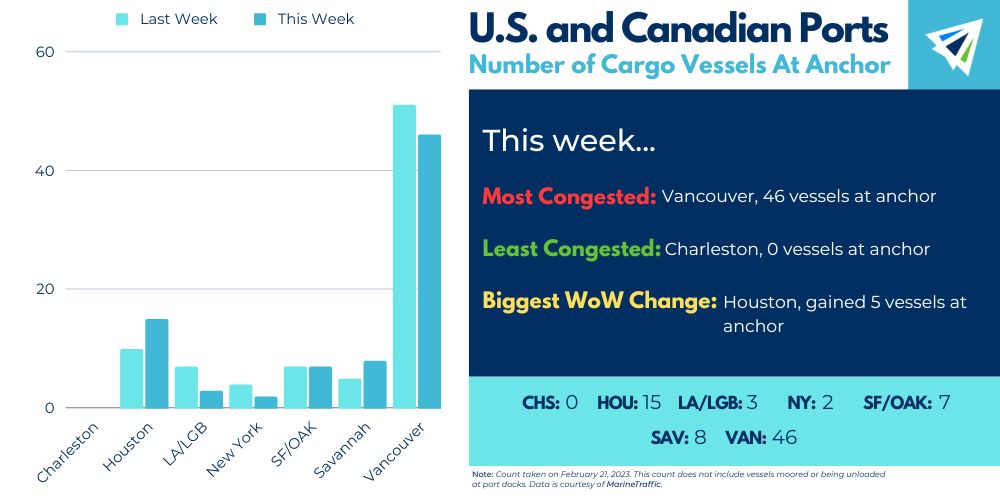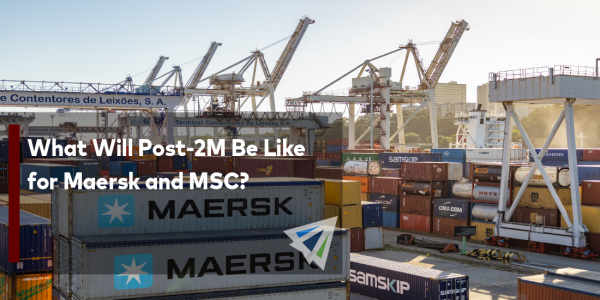Competitive Edge
February 22nd, 2023

Have another North American port you would like for us to track weekly? Email us at sales@interlogusa.com
Takeaways
• U.S. West Coast: This week, Los Angeles and Long Beach has had one of their lowest combined vessel queues as of recent. Meanwhile, the Bay Area ports stood pat with no week-over-week change. In now what feels like inevitable tradition, another week passes without an agreement for a new West Coast dockworker agreement.
• U.S. Gulf Coast: The Gulf Coast port’s dwell fee program went into effect February 1. The Port of Houston will charge $45 per unit per day to cargo owners if a container lingers for more than eight days.
• U.S. East Coast: Charleston better watch its weight. It’s now been two straight weeks of donuts as the port enjoys zero vessels queued off it shore. Both Savannah and New York also remain minimally congested–an unsurprisingly result to report.
IMPORT: Asia to North America (TPEB)
Recent Developments:
• Carriers remain aggressive with blank sailings and general rate increases to buff up and stabilize low rates.
• West Coast contract negotiations between the International Longshore and Warehouse Union (ILWU) and Pacific Maritime Association (PMA) remain active. The existing labor contract between the two parties expired on July 1, 2022
Rates: Rates to all US coasts are low and level.
Space: Space is open.
Capacity: Capacity is open. However, expect a continued presence of blank sailings.
Equipment: Unless directly advised otherwise, availability is open at inland and coastal ports.
TIPS:
• Book at least two weeks prior to the ready date.
• Expect blank sailings to carry on through Q1 2023.
IMPORT: Europe to North America (TAWB)
Rates: With capacity increasing and demand dropping, rates remain falling for this trade. However, they are still notably high when compared to pre-pandemic levels.
Space: Space is open to all U.S. coasts.
Capacity: Capacity continues to loosen as the market sees more ships, including larger ones, entering the market.
Equipment: Availability has improved on both sides of the trade.
TIPS:
• Book at least three weeks prior to ready date.
• Even as market conditions become more fair, premium services (i.e., no-roll options and improved cargo reliability) should still be considered.
• Blank sailings have not been routine for the market but remain in close contact with providers to be aware of any developments.
EXPORT: North America to Asia
Recent Developments:
• The typical yearly pickup in agricultural exports should garner a pleasant surge in outbound volume, however it should not come close to tightening the market’s loose capacity.
Rates: Rates continue to slip downward at a slight clip.
Space: Space is wide open.
Capacity: Capacity is widely available for all services. No considerable changes to this market’s capacity through Q1 2023.
Equipment: It can be generally said that most inland points and seaports have balanced equipment availability. No outstanding challenges at the present.
TIPS:
• Book at least three weeks prior to the time of departure.
• Blank sailings have not been routine for the market but remain in close contact with providers to be aware of any developments.
• Shippers with high volume projects should take advantage of carrier receptiveness to take on these opportunities. Space is wide open with a high acceptance rate.
InterlogUSA Proudly Presents...Freight FM Ep. 5: Discussing the China Trade Lane
In our latest episode, InterlogUSA’s Rachel and Madison discuss the China trade lane and what importers can expect after Chinese New Year.
If you are a China importer, you’ll want to check this episode out!
“Freight FM” features short-form video interviews with InterlogUSA’s industry experts offering insights into breaking news, market trends, our company’s history, and more!
Container Volume Down at Port of Savannah and Port of Houston
Port of Savannah:
For the month of January, the Port of Savannah saw their total cargo throughout decrease by 11.5 percent.
Though, they did see a 21 percent year-over-year increase in exports.
Port of Houston:
For the month of January, container volume at the port dipped slightly compared to last January, by 1 percent (3,437 TEUs).
Loaded imports were down 6 percent but total imports were up 5 percent.
Additionally, the port saw a large amount of growth in loaded exports, increasing by 31 percent compared to last year to 113,875 TEUs for the month.
Sources: AJOT and Freightwaves
Freight News
Dry Bulk Market Off to a Rocky Start
The dry bulk market has not started the year off on a good note, in fact it’s off to one of its worst starts ever in 2023.
The Baltic Dry Index (BDI) – is an index of average prices paid for the transport of dry bulk materials across more than 20 routes.
Many often view the BDI as a leading indicator of economic activity because the changes in the index reflect supply and demand for important materials used in manufacturing.
Last Thursday, the BDI fell to 530 points on Thursday, which is down 91% compared to October 2021 – according to Freightwaves.
Even though this year for dry bulk has not been great and the BDI is very low, some in the industry believe there should still be some optimism toward dry bulk for this year.
One reason for that is, once one-off COVID fallout passes, China will resume higher industrial activity and thus higher bulk imports.
So, if China does rebound, dry bulk is more leveraged than any other shipping sector to demand upside, Freightwaves notes.
South Carolina Ports Provide Stable Service and Reliability to Shippers
Shippers can benefit from the efficient operations at the South Carolina Ports, as well as the Charleston deep harbor – which is the deepest on the U.S. East Coast, at 52 feet. The deeper channel smoothly handles ships fully laden with heavy exports and imports.
So far this fiscal year, the ports have handled close to 1.6 million TEUs (twenty foot equivalent units) and 867,256 pier containers – which is regarding to containers of any size.
Additionally, loaded exports have increased nearly 11 percent in January – trending positively for a region that has a ‘booming’ automotive industry.
The ports are also expanding their intermodal capabilities. With receiving $400 million in state funding, a site is being created to be turned into a modern, rail-served cargo yard. It is set to open in 2025, per the American Journal of Transportation.
The South Carolina ports are thrilled as this facility will allow them to move cargo more seamlessly between the port and inland markets, as well as support SC Ports’ rail-served Inland Ports in Greer and Dillon.
Watch Our February Webinar!
Topics:
- CNY/Trade Lane Predictions
- Blank Sailings
- Benefits of Outsourcing Your Logistics
Sign Up for Next Month's Webinar
Our next webinar will be on Wednesday, March 15th!
We would like to hear from you. If you have any questions or topics you would like our experts to discuss in future webinars, please let us know!
Interlog  Insights
Insights
In last week’s newsletter, what import volume is expected to look like throughout the first half of this year.
Don’t forget to sign up so you can receive upcoming insights!
Sign up for our
industry answers
Our team works to provide valuable, unique, and relevant content to assist you in finding solutions. Sign up now.

